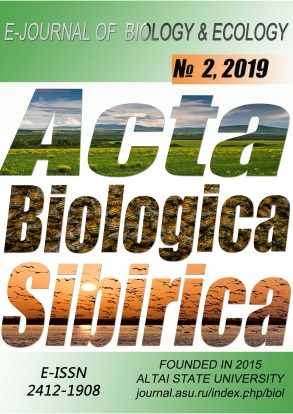Abstract
The results of the analysis of literature and original data on ecology and geographical distribution of 5 Eucocconeis P.T. Cleve species in the algal flora of West Siberia are given. Information relevant to halobility, active water reaction, saprogenity and geographical distribution is presented for each of species.
References
Bogdanov, V.D., Bogdanova, E.N., Goskova, O.A., Melnichenko, I.P. Stepanov, L.N., Yarushina, M.I. (2005). Ehkologicheskoe sostoyanie pritokov nizhnej Obi (reki-Harbej, Longotegan, Shchuchya). Ekaterinburg. Ural University Press (In Russian).
Chekryzheva, T.A. (2012). Taksonomicheskaya i ehkologicheskaya harakteristika fitoplanktona Onezhskogo ozera. In: Trudy Karelskogo nauchnogo centra RAN, 1, 56-69 (In Russian).
Cleve–Euler, A. (1953). Die Diatomeen von Schweden und Finnland. Stockholm. 3.
Diatomovyj analiz: opredelitel iskopaemyh i sovremennyh diatomovyh vodoroslej. (1950). Gosgeolizdat, Leningrad. 3 (In Russian).
Foged, N. (1964). Freshwater diatoms from Spitzbergen. Tromsä / Oslo. Universitets forlaget, 11, 1–205.
Gecen, M.V, Stenina, A.S., (1978). Sistematicheskij spisoksporovyh i vysshih cvetkovyh rastenij (gigro- i gidrofity) Bol'shezemel'skoj tundry. Algae. Flora i fauna vodoemov evropejskogo Severa. Leningrad: Nauka (In Russian).
Genkal, S.I., Chekryzheva, T.A. Komulajnen, S.F. (2015). Diatomovye vodorosli vodoemov i vodotokov Karelii. Moscow: Nauchnyj mir (In Russian).
Genkal, S.I., Semenova, L.A. (1999). Novye dannye k flore Bacillariophyta Obskogo Severa. Zhurn. biologiya vnutrennih vod, 1-3, 7-20 (In Russian).
Genkal, S.I., Trifonova, I.S. (2009). Diatomovye vodorosli planktona Ladozhskogo ozera i vodoemov ego bassejna. Rybinsk. OAO Rybinskij dom pechati (In Russian).
Genkal, S.I., Vekhov, N.V. (2007). Diatomovye vodorosli Russkoj Arktiki: arhipelag Novaya Zemlya i ostrov Vajgach. Moscow: Nauka (In Russian).
Guiry, M.D., Guiry, G.M., (2019). AlgaeBase. World-wide electronic publication, National University of Ireland, Galway. Available from: http://www.algaebase.org/ Accessed on 28 March 2019.
Haritonov, V.G., Genkal, S.I. (2012). Diatomovye vodorosli ozera Ehlgygytgyn I ego okrestnostej (Chukotka). Magadan: North-East Science Center of Far Eastern Branch of Russian Academy of Science (In Russian).
Igoshkina, I.Yu. (2014). Vidovoj sostav i struktura fitoplanktona vodoema prirodnogo parka Ptichya gavan. Omskij nauchnyj ecologichniy vestnik, 1(128), 182-185 (In Russian).
Kagan, L. Ya. (2012). Diatomovye vodorosli Evro-Arkticheskogo regiona. Annotirovannaya kollekciya drevnie I sovremennye morskie i presnovodnye. Apatity: Izdatelstvo KNC RAN (In Russian).
Kim, G. V. (2015). Fitoehpiliton vodotokov i vodoemov gornoj i predgornoj chastej bassejna Verhnej Obi. Thesis of Doctoral Dissertation. Novoaibirsk (in Russian).
Kulikovskij, M. S., Glushchenko, A.M., Genkal, S. I., Kuznecova, I.V. (2016). Opredelitel diatomovyh vodoroslej Rossii. Yaroslavl, Filigran (In Russian).
Lange-Bertalot, H., Krammer, K. (1989). Achnanthes. Eine Monographie der Gattung mit Definition der Gattung Cocconeis und Nachtragen zu den Naviculaceae. Bibliotheca Diatomologica. Berlin; Stuttgart. Germany: J. Cramer, 18, 393.
Medvedeva, L.A., Nikulina, T.V. (2014). Katalog presnovodnyh vodoroslej yuga Dalnego Vostoka Rossii. Vladivostok: Dalnauka (In Russian).
Mitrofanova, E.Yu., Skabichevskaya, N.A., Kim, G.V., Romanov, R.E. (2007). Flora diatomovyh vodoroslej Teleckogo ozera (Altai, Russia). Systematical News of Non-Vascular Plants, 41, 41-59 (In Russian).
Poreckij, V.S. (1933). Diatomovye gornyh ozer okrestnostej Teleckogo ozera(Altaj). Issledovaniya ozer SSSR. 3. Leningrad: State Hydrological Institute Press (In Russian).
Poreckij, V.S., Sheshukova, V.S. (1953). Diatomovye Teleckogo ozera I svyazannyh s nim rek. Diatomovyj sb. Leningrad State University, 107-172 (In Russian).
Potapova, M.G. (2018). New and rare Psammothidium species (Bacillariophyta, Achnanthidiaceae) from Northeastern Siberia. Cryptogamie Algologie, 39(4), 465-479.
Safonova, T.A. (2007). Vodorosli. Flora Salairskogo kryazha. Novosibirsk: Akademicheskoe izdatelstvo “Geo” (In Russian).
Semenova, L.A., Naumenko, Yu.V. (2001). Novye dannye k algoflore Nizhnej Obi i ee ehstuariya. Vestnik ehkologii, lesovedeniya i landshaftovedeniya 2: 131-137. (In Russian). (Семенова Л.А., Науменко Ю.В. Новые данные к альгофлоре Нижней Оби и ее эстуария // Вестник экологии, лесоведения и ландшафтоведения. (2001). Вып. 2. С. (131-137.).
Yarushina, M. I. (2007). Fitoplankton vodoemov bassejna r Messoyaha (Gydanskij poluostrov). Nauchnyj vestnik Yamalo-Neneckogo avtonomnogo okruga, 2(46), 18-31 (In Russian).
Zabelina, M.M., Kiselev, I.A., Proshkina–Lavrenko, A.I., Sheshukova, V.S. (1951). Opredelitel presnovodnyh vodoroslej SSSR. Vyp. 4. Diatomovye Vodorosli - Bacillariophyta. Moscow: Nauka (In Russian).
Acta Biologica Sibirica is a golden publisher, as we allow self-archiving, but most importantly we are fully transparent about your rights.
Authors may present and discuss their findings ahead of publication: at biological or scientific conferences, on preprint servers, in public databases, and in blogs, wikis, tweets, and other informal communication channels.
ABS allows authors to deposit manuscripts (currently under review or those for intended submission to ABS) in non-commercial, pre-print servers such as ArXiv.
Authors who publish with this journal agree to the following terms:
- Authors retain copyright and grant the journal right of first publication with the work simultaneously licensed under a Creative Commons Attribution License (CC BY 4.0) that allows others to share the work with an acknowledgement of the work's authorship and initial publication in this journal.
- Authors are able to enter into separate, additional contractual arrangements for the non-exclusive distribution of the journal's published version of the work (e.g., post it to an institutional repository or publish it in a book), with an acknowledgement of its initial publication in this journal.
- Authors are permitted and encouraged to post their work online (e.g., in institutional repositories or on their website) prior to and during the submission process, as it can lead to productive exchanges, as well as earlier and greater citation of published work (See The Effect of Open Access).





